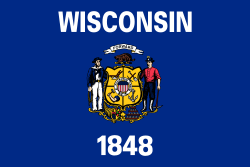
Wisconsin Archivist :
- WISCONSIN FAST FACTS -
 Wisconsin has a land area of 65,478 square miles which is divided into 72 counties. It is located in the Midwest (north-central) United States. It is one of the
eight states that make up the Great Lakes region. Wisconsin Territory was formed by an act of Congress on April 20, 1836 and admitted to the Union, as the 30th state, on May 29, 1848.
Wisconsin has a land area of 65,478 square miles which is divided into 72 counties. It is located in the Midwest (north-central) United States. It is one of the
eight states that make up the Great Lakes region. Wisconsin Territory was formed by an act of Congress on April 20, 1836 and admitted to the Union, as the 30th state, on May 29, 1848.
Wisconsin is bounded on the north by Lake Superior, upper peninsula of Michigan on the northeast, Lake Michigan on the east, Illinois and Iowa sharing the southern boundary, and Minnesota on the west. The capital is located at Madison and the largest city is the port city (Lake Michigan) of Milwaukee.
 It is believed that the first European to visit what would become Wisconsin was the
French explorer Jean Nicolet in 1634. Leaving Georgian Bay in a canoe he passed through
the Straits of Mackinac and came ashore at Red Banks near Green Bay. Soon he would be
followed by others, including Jacques Marquette and Louis Joliet in 1673. The first settler, Charles Michel de Langlade, established
a trading post at Green Bay in 1745. A tremendous wave of immigration followed the opening of
the Erie Canal in 1825. At the time of the 1820 Federal Census Wisconsin's population was only 1,444, which grew to 305,391 by 1850. The 2010 Federal Census shows a population of 5,686,986.
Approximately one-third of the population reside in Milwaukee.
It is believed that the first European to visit what would become Wisconsin was the
French explorer Jean Nicolet in 1634. Leaving Georgian Bay in a canoe he passed through
the Straits of Mackinac and came ashore at Red Banks near Green Bay. Soon he would be
followed by others, including Jacques Marquette and Louis Joliet in 1673. The first settler, Charles Michel de Langlade, established
a trading post at Green Bay in 1745. A tremendous wave of immigration followed the opening of
the Erie Canal in 1825. At the time of the 1820 Federal Census Wisconsin's population was only 1,444, which grew to 305,391 by 1850. The 2010 Federal Census shows a population of 5,686,986.
Approximately one-third of the population reside in Milwaukee.
Well known for it's dairy production and beer industry, Wisconsin also has a rich maritime history. It was from Washington Island that Rene-Robert Cavelier, Sieur de LaSalle's tiny Le Griffon (The Griffin), the first commercial vessel to be used in the New World, set sail in August, 1679, bound for Niagara loaded with furs, never to be seen again. It was from the Burlington Northern Railroad Dock No. 1, in Superior, that the SS Edmund Fitzgerald departed on what would be her final run. It was at harbors like Superior, Green Bay, Manitowoc, Sturgeon Bay, Sheboygan, Milwaukee and Racine that many of our ancestors arrived. From those same harbors were carried iron ore, lumber, limestone, and a variety of foods needed nationwide.
The genealogical records held here are for use by the general public. These records have been submitted to the USGenNet Data Repository by volunteers and researchers just like you for permanent on-line free-access.




